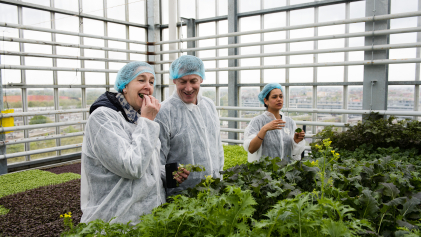Data-driven cities
Businesses, researchers and government have written volumes about the opportunities and risks of smart cities. But how is smart city technology impacting people down on the ground? Rathenau Instituut researchers Iris Korthagen, Damion Bunders and Rinie van Est have investigated this question. In this article: what are the five biggest Dutch cities doing with smart technology, and why?

This article is one in a series of three.
What is a smart city?
Smart cities use data and smart information technology. Technology is ‘smart’ if it can observe, analyse and act on its own. An example would be stoplights that switch to green for cyclists when it’s raining.
Dutch cities have clearly jumped on the smart city bandwagon. In early 2017, two networks formed by the country’s five largest cities (the ‘G5’) and 32 medium-sized to large cities (the ‘G32’) handed Prime Minister Mark Rutte their NL Smart City Strategy, conceived in partnership with the private sector and knowledge institutions. Municipal governments have also drafted their own agendas and strategies addressing the use of data and smart technologies in their cities.
In this study, we focused on the ‘G5’ cities – Amsterdam, Rotterdam, The Hague, Utrecht and Eindhoven –and found that they set up projects to use data and smart technology to:
- provide services and produce and implement policy more efficiently and effectively
- facilitate innovation
- and/or involve the local community more closely in policymaking.
In other words: their three aims are optimisation, innovation and public participation. Below we look in detail at each of these aims and provide examples of each from the five largest Dutch cities.
Aim 1: Make policy more efficient and effective
Municipal governments want to use smart city projects to optimise their services and policy implementation processes. This is in fact the aim that we noted most frequently in our study.
Expectations
The G5 municipal governments have dedicated research and statistics departments that collect and analyse data, for example on the population, the local economy, health matters, social security, public safety or education. They use these data to gain a better picture of the issues in various domains and to help them decide on possible solutions.
A growing amount of data is collected and stored digitally, making new forms of analysis possible, for example linking datasets and discovering new correlations. Scenarios can be produced on that basis, giving the municipality the opportunity to take action. Digitisation also makes it possible to collect data in real time; instead of quarterly reports, we now have minute-by-minute feedback.
Finally, smart technology can itself take action based on the data it has collected and analysed. One example would be matrix signs informing the public that certain market squares are already filled to capacity during an event. When technology takes decisions without human intervention, we say that it is fully automated.
Reality
We saw very few projects in Dutch cities involving fully automated technology. Many so far focus on investigating the potential of data. Can collecting more real-time data or combining data lead to more knowledge and evidence, more accurate forecasting, greater efficiency and effectiveness, or more influence on behaviour?
We noted two different real-life examples.
Data-driven decision-making
The city of Utrecht uses data to optimise the management and maintenance of its water pumps (interview with City of Utrecht). Before, the city would inspect the pumps every year. Historical data revealed that most of the pumps functioned perfectly. The municipal government consequently decided to replace the few pumps that did malfunction and to reduce inspections from then on to once every three years (interview with the City of Utrecht). The data had produced more knowledge and evidence about the specific problem, which the municipal government hoped would lead to a more effective and efficient pump management system.
In The Hague, sensors have been installed to monitor the machinery and systems of the municipal bathing pool (interview 2 with the City of The Hague). Using sensors to link systems and machinery to the internet is known as the Internet of Things (IoT). The data is used to make maintenance more effective and efficient.
Various cities are running experiments with predictive policing to improve the efficiency and effectiveness of police deployment. Flexible policing teams patrol the highest-risk neighbourhoods. These neighbourhoods are selected based on historical data, for example the sites of previous high-impact crimes[1]. Before, extra policing capacity went to the police officers who argued hardest for it; now, decision-making is based on statistics (interview with the City of Utrecht). The figures indicate that deployment of the flexible policing team has led to a decline in crime. The Crime Forecasting System (CAS) will be rolled out throughout the Netherlands.
Automated decisions
In the Stratumseind entertainment district in Eindhoven, the police use cameras, noise sensors and data analyses to track visitor flows and behaviour on the streets. On-street lighting adjusts automatically to the data and feedback, the idea being to influence visitor behaviour (interview with the City of Eindhoven). Continuous monitoring also means that the police can intervene rapidly when they feel it’s necessary. Law enforcement professionals and technology share control in this system.
Monitoring and disciplining behaviour can also be fully automated. Smart cameras in a bicycle parking facility in Utrecht count the empty spaces. The system uses signboards and app alerts to send cyclists to the facility with the largest number of empty spaces. The city has also run a very small pilot project using an algorithmic housekeeping ledger to make automatic rent or power bill payments in debt assistance cases (interview with the City of Utrecht).
Aim 2: Cooperate in innovation
Innovation is the second important aim that municipal governments work towards with smart technology projects.
Expectations
Municipal governments reason that experimenting with data and smart technology will lead to economic progress, an increase in local prosperity and a stimulating environment for knowledge workers.
There are often economic reasons for making municipal data available. Municipal governments expect that businesses can use their data to develop new products or services (interview with Creating010 Rotterdam).
Reality
The five largest cities are working with knowledge institutions and businesses on innovative solutions for urban problems, such as crowding, pollution or crime. Cities are, for example, acting as civil society partners in research projects or offering themselves as ‘living labs’ for experiments using innovative technology for socially relevant purposes.
A small section of the Scheveningen area of The Hague has become a ‘living lab’. Lamp posts in this area have been fitted with smart technology that turns them into test stations for the Internet of Things (IoT), for example cameras that track visitor flows or chips that send signals to smartphones. This means that the area is now set up to explore new IoT-based business models and to study the value of technology for society (interview 1 with the City of The Hague).
A closer look at living labs
In a recent report, the Rathenau Instituut discussed the many different smart partnerships that have been established in cities, known as living labs. It should be noted that not all of these partnerships are new. Digitisation eases on-site experimentation, making it possible to collect data in public spaces. One concern is that the knowledge accumulated in these small-scale experiments could be lost. In addition, if living labs are to contribute to broader societal aims, then co-creation with the public is crucial.
The economic motive behind the quest for data- and technology-driven innovation is also apparent in the overall approach taken by the City of Amsterdam. There, the Amsterdam Economic Board is coordinating the Amsterdam Smart City platform, whose aim is to promote sustainable economic growth, help new markets develop, and encourage revenue models for innovative solutions (Amsterdam Smart City, 2014).
Social and economic innovation can also inspire cities to take part in competitions or EU funding programmes. It is financially appealing in such cases to cooperate with knowledge institutions and innovative businesses. For example, the City of Rotterdam and its partners won an EU Horizon2020 grant worth millions of euros for a smart city project involving experiments in Rotterdam-Zuid and other districts (interview with the City of Rotterdam). The project focuses on improving energy efficiency and reducing carbon emissions, with other aims being to stimulate employment opportunities, encourage public participation and improve the quality of life for the city’s residents (website, consulted 6 September 2017).
Aim 3: Involve local residents
The third aim that we encountered in this study is public participation. Municipal governments want to involve local residents in smart city projects.
Expectations
Municipal governments can involve the local population in collecting and analysing data and/or in developing and testing applications. Participation can help generate a basis of support in the community. It can also help make a data application or new technology more valuable to the community. The initiative can come from the municipal government, but also from civil society organisations or local residents themselves.
Reality
Municipal governments can work with local residents to develop digital applications. Various cities have already attempted this with open data projects. To their disappointment, co-creation with local residents turned out to be very difficult in the case of open data projects. Not everyone had the necessary skills, for example, and not all data can simply be converted into applications that have relevance for society. It costs time and money to make municipal data accessible. That is why the City of Rotterdam only makes data publicly available on request. For example, someone who was developing an exercise program asked for a list of all street furniture – benches and tables – and their locations. The city was happy to provide the list (interview with the City of Rotterdam).
Another approach is to involve a specific target group in the design process. In The Hague, the municipal government ran a project exploring how digital technologies can help senior citizens live independently for longer. A panel of elderly persons was involved in the design process, not only to test the technology but also, and more importantly, to discuss their specific needs and concerns. The project team ultimately selected the technologies based on these discussions.
City-dwellers can also get involved in certain issues and collect data that supports their position. For example, people who live near a major artery in Rotterdam, the ‘s Gravendijkwal, were affected by air pollution. They carried out their own air quality tests in cooperation with Friends of the Earth Netherlands and managed to convince the municipal government of the seriousness of the problem. The municipal government then banned all lorry traffic from this road (interview with Creating 010). A good example of local residents taking the initiative to use data.
Would you like to read more?
Read part two of the series: Are smart-city practices putting pressure on public values?
[1] crimes that have a major impact on the victim: home burglaries, muggings, violent offences and hold-ups; see e.g. (in Dutch) https://www.rijksoverheid.nl/actueel/nieuws/2016/05/19/high-impact-crimes-op-laagste-niveau-in-afgelopen-tien-jaar
